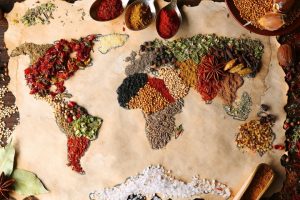Food is more than just something to eat; it has deep meaning that reflects history, society, and identity. Over time, political events, social changes, and cultural exchanges have had a huge impact on changes in cuisine. By studying how history has influenced the cuisines of different countries, we can learn more about how global cuisines have changed and evolved, showing the range of human experience and creativity.
1. The Role of Trade and Exploration
Trade and travel have greatly influenced the foods of different cultures. As people in ancient societies traveled for trade, they encountered new foods, cooking methods, and flavors that changed the way they ate. For example, the Silk Road was a system of trade routes that connected Asia and Europe, making it easier for people to trade goods such as fruits, vegetables, and spices. Through the sharing of cultures, foods such as saffron, cinnamon, and almonds were brought to different regions, improving their diets.
2. Changes Caused by Colonialism
Colonialism had a huge impact on local food systems and cooking methods. European settlers often brought their own food tastes and agricultural practices to the places they inhabited. As a result, European crops and animals were brought to new areas, sometimes replacing native foods. In many cases, local people adapted to these changes by adding new foods to what they were already cooking.
3. Migration and Diaspora Influences
Immigrant and diaspora communities brought different cooking methods to new places, which had a huge impact on cultural foods. As people moved across borders in search of better jobs, they brought their eating habits with them and changed them to fit the tastes and ingredients of their new home. The mix of cooking styles led to different regions creating their special dishes to showcase the people who made them.
4. Impact of War and Conflict
Wars and conflicts also had a huge impact on the foods of different cultures. During wartime, when food was limited or rationed, people often invented new recipes and cooking methods. For example, during World War II, when ingredients were hard to come by, people invented recipes using what they had on hand, such as wartime versions of classic dishes.
Conflict also sometimes leads to the preservation of food customs as a way to maintain cultural identity. For example, in places where political unrest or conflict is prevalent, traditional foods can help people defend their traditions and resist cultural assimilation. As a result, traditional cooking methods will continue to change and gain popularity, even as outside forces try to change them.
5. Technological Advances
The way we make and eat food is constantly changing thanks to new technologies. New cooking utensils, ways to keep food fresh, and ways to transport food have all changed the way people cook and what ingredients are available. For example, the invention of the refrigerator and the tin can in the 19th century changed the way food was stored and transported over long distances.
6. Cultural Exchange and Global Communication
In recent decades, globalization has made it easier for people around the world to share their cooking methods. There are more foreign food chains, food blogs, and cooking shows than ever before, making it easier for people to try dishes from different cultures. Because food from different countries is more accessible, more people are eating it. This allows us to appreciate the diversity of food from around the world.
7. Preserving Food History
As history continues to shape cultural foods, more people are realizing the importance of preserving and enjoying our culinary heritage. To preserve the diversity and richness of world cuisine, it is important to keep traditional recipes safe, promote local ingredients, and support small food suppliers. By recognizing how history has shaped food and creating opportunities for cultural exchange, we can ensure that food culture continues to survive and change in the modern world.
Conclusion
In conclusion, the history of food shows how everything in our lives is interconnected. From the trade routes of the past to the globalization of today, historical events have had a huge impact on the growth and diversity of ethnic foods. By looking at how history has influenced cooking methods, we can see how food continues to change and evolve. We can celebrate the traditions that are part of our national identity and the new ideas that will shape our culinary future.
FAQs
1. How have past trade routes changed food around the world?
Historical trade routes such as the Silk Road and the Columbian Trade were important in creating global cuisine because they made it easier for people from different regions to share foods, spices, and cooking methods. This exchange of ideas brought new flavors and ingredients to many parts of the world, improving local cuisine and creating new food traditions.
2. How did colonialism change Aboriginal food systems?
During the colonial period, European crops and animals were often brought into controlled areas, sometimes replacing native foods. However, native people often adapted to these changes by adding new ingredients to their cooking, creating a unique fusion cuisine that combines colonial and native influences.
3. How has exercise changed the way people in different cultures eat?
Immigrants brought different culinary practices to new areas and had a significant impact on cultural eating habits. People who move to a new area often change traditional recipes to adapt to the products and tastes of the new area, creating a unique local cuisine. This mix of cooking styles changes the food culture of the host country for the better while preserving some of the original cooking styles of the refugees.
4. How have wars and other conflicts changed food traditions?
Wars and other conflicts often resulted in food shortages and rationalizations, causing people to invent new recipes and cooking methods to make use of what they had available. Sometimes food habits are maintained as a way to protect cultural identity and combat cultural assimilation in times of external pressure or change.
5. How has technological change affected the way people cook?
New technologies such as refrigeration, canning, and modern kitchen appliances have changed the way people cook by making it easier to store, prepare, and transport food. These new technologies make it easier to try different recipes every day and prepare dishes from all over the world.
6. How has globalization affected the way people cook today?
Globalization has accelerated the sharing of cooking methods around the world, making it easier for people to try many different types of food. This has led to a greater appreciation for the diversity of food around the world but has also raised concerns that traditional recipes could become fast food and lose their authenticity.




